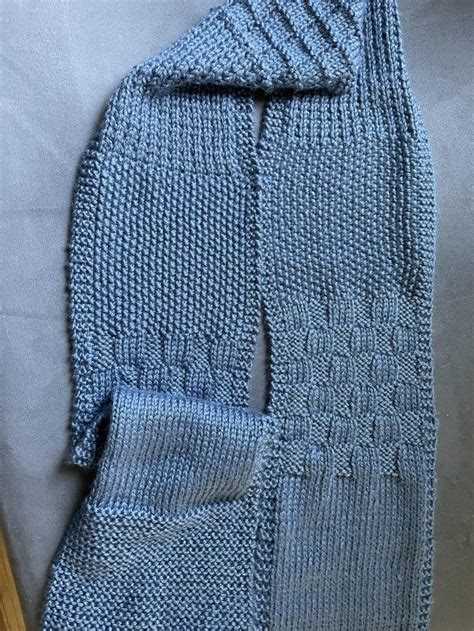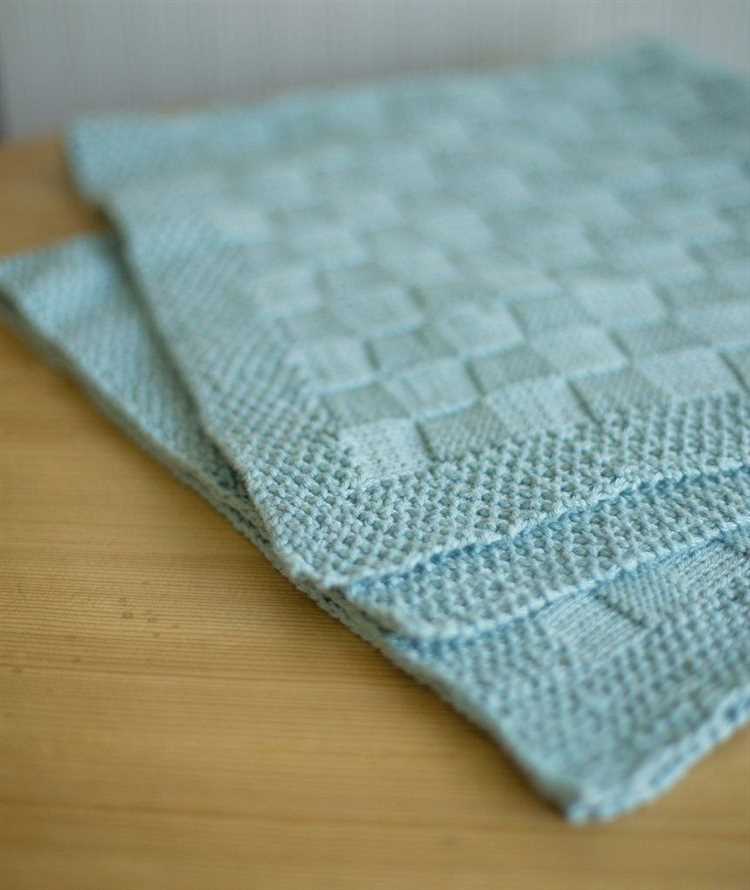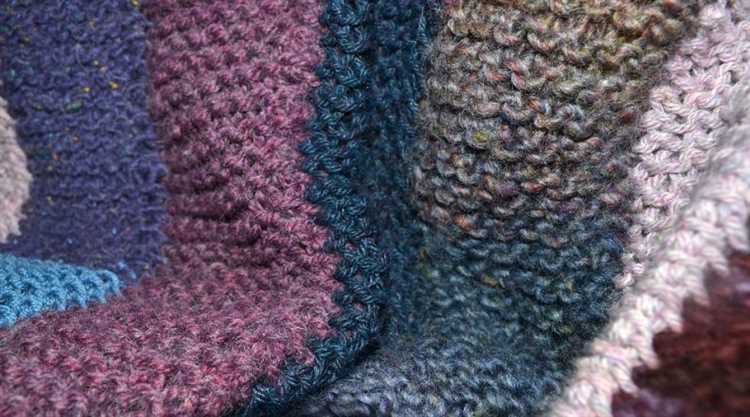Knitting is not only a relaxing and creative hobby, but it also allows you to create beautiful and cozy garments and accessories. However, after completing a project, it is essential to block your knitted piece to give it a professional finish and ensure that it maintains its shape and drape.
Blocking is the process of wetting or steaming your knitted item, then gently reshaping and drying it to the desired dimensions. This step is especially crucial for lace and delicate stitches, as it opens up the pattern and evens out any inconsistencies.
In this step-by-step guide, we will walk you through the process of blocking a knitted project, whether it’s a shawl, sweater, or even a pair of socks. With a little patience and attention to detail, you can transform your handmade knits into stunning, polished masterpieces.
Step 1: Gathering the necessary materials
To block your knitted project, you will need a few essential tools and materials. These include:
- Blocking mats or a clean, flat surface
- Pins or blocking wires
- A spray bottle or basin for wet blocking
- A steam iron or steamer for steam blocking
- A tape measure or ruler
Make sure to choose blocking mats that are large enough to accommodate your project. Blocking wires are ideal for creating straight edges, while pins are suitable for shaping curves and maintaining dimensions.
Step 2: Preparing your project for blocking
Before starting the blocking process, you need to clean your knitted item according to the yarn’s care instructions. Handwashing is usually the safest method, but some yarns may be machine washable.
After washing, gently squeeze out the excess water without wringing or twisting the garment. Lay your project on a clean towel and roll it up to remove any remaining moisture. Now, your knitted piece is ready for blocking!
Step 3: Choosing the blocking method
There are two primary methods for blocking knitted projects: wet blocking and steam blocking.
Wet blocking involves immersing your knitted item in water, then gently squeezing it out before shaping and drying it. This method is suitable for natural fibers like wool and cotton.
Steam blocking utilizes the heat and moisture from steam to reshape your knitted item. This method is ideal for acrylic and synthetic fibers that cannot be wet without losing their shape.
Make sure to read the yarn label and choose the appropriate blocking method for your project.
Step 4: Blocking your knitted project
Now it’s time to block your knitted project! Lay out your blocking mats or a clean, flat surface, ensuring there is enough space to accommodate your garment without any overlap.
If you’re wet blocking, dampen your project with water using a spray bottle or by immersing it in a basin. Gently squeeze out any excess moisture without wringing, then shape and pin your garment to the desired measurements, making sure the edges are straight and the lace, stitches, or cables are well-defined.
For steam blocking, hold the steam iron or steamer a few inches away from the knitted item, moving it slowly and evenly to avoid scorching or melting the fibers. Use your hands to shape the item as the steam softens the fibers, then pin it in place.
Step 5: Allowing your project to dry
Once your project is blocked to your satisfaction, let it dry completely. This process may take a day or two, depending on the thickness and fiber content of your yarn.
Avoid moving or disturbing the project while it’s drying to prevent any changes in shape or measurements. Once dry, remove the pins or wires, and marvel at the beautifully blocked knitted item you’ve created!
Blocking is an essential step in the knitting process that gives your handmade projects a professional and polished finish. By following this step-by-step guide, you can ensure that your knitted items maintain their shape, drape, and overall aesthetic, allowing you to showcase your knitting skills and creativity.
Preparing the Knitted Project
Before starting the blocking process, there are a few steps you need to take to prepare your knitted project:
- Finish any remaining knitting. Ensure that you have completed all knitting stitches and any necessary bind-off or cast-on stitches before moving on to blocking.
- Weave in loose ends. Use a yarn needle to carefully weave in any loose ends on your knitted project. This will give it a neater appearance and prevent any ends from unraveling during the blocking process.
- Clean your project (if required). If your knitted project needs to be washed or cleaned before blocking, refer to the yarn label for specific instructions on how to clean the material. Follow the recommended washing method and let your project air dry completely before moving on.
- Obtain necessary blocking supplies. Gather all the supplies you will need for blocking, such as blocking mats or towels, rustproof pins, blocking wires, measuring tape, and a spray bottle filled with water. Having these items ready will make the blocking process smoother.
Once you have completed these preparatory steps, you are ready to move on to the next stage of blocking your knitted project.
Soaking the Knitted Project
Before blocking your knitted project, it is essential to soak it in water. This step helps the fibers relax and allows you to reshape the item to your desired dimensions.
Here is how you can soak your knitted project:
- Fill a basin or sink with lukewarm water. Avoid using hot water as it can cause the fibers to shrink or felt.
- Add a few drops of mild detergent or a dedicated wool wash to the water. Gently swirl the water to distribute the detergent.
- Place your knitted project into the water, making sure it is completely submerged. If needed, you can gently press down on the item to make sure it is fully soaked.
- Let the project soak for about 15-20 minutes. During this time, the fibers will absorb the water and become more pliable.
- After the soaking time is complete, carefully lift the project out of the water and gently squeeze it to remove excess water. Avoid wringing or twisting the item, as this can damage the fibers.
- Place a towel on a flat surface and lay the knitted project on top. Roll up the towel, pressing down gently to further remove excess water.
Once your knitted project has been soaked and excess water has been removed, it is ready for the blocking process. This step ensures that your project retains its shape and gives it a more professional finish.
Removing Excess Water
After the blocking process, it is important to remove excess water from your knitted project before allowing it to dry completely. Here are the steps to remove excess water:
- Gently squeeze the knitted project to remove as much water as possible. Be careful not to wring or twist the fabric, as this can damage the fibers and affect the final shape.
- Lay the project flat on a clean towel or an absorbent surface. Roll up the towel with the project inside, applying gentle pressure to help absorb more moisture.
- Unroll the towel and remove the project. Replace the damp towel with a dry one and repeat the rolling process. This helps to further remove any remaining water.
- If the project is still quite wet, you can repeat the rolling process with a third towel to absorb even more moisture.
- Once most of the excess water has been removed, you can proceed with allowing the project to dry completely on a flat surface.
Remember not to wring or hang the project to dry, as this can stretch the fibers and distort the knitted fabric. By properly removing excess water, you ensure that your knitted project dries evenly and retains its shape.
Setting Up Blocking Tools
Before you begin blocking your knitted project, it’s important to gather all the necessary tools and materials. Here are the items you’ll need:
- Blocking mats: These mats provide a flat and even surface for blocking your knitting. They can be made of foam or cork and are often interlocking, allowing for easy customization of the blocking area.
- Pins: Stainless steel or rust-proof pins are best for blocking. You’ll use these to secure your project to the blocking mats.
- Tape measure: A tape measure will help you accurately determine the size and dimensions of your knitting.
- Spray bottle: Fill a spray bottle with water to lightly mist your knitted project before blocking.
- Blocking wires: These flexible wires are useful for creating straight edges and ensuring that your project maintains its desired shape.
- Towels: Place towels underneath your blocking mats to absorb any excess moisture.
- Measuring tape or ruler: Use a measuring tape or ruler to double-check your project’s size and proportions.
Make sure to set up your blocking area in a well-ventilated space, allowing your project to dry properly after blocking. It’s also important to follow any specific instructions or recommendations provided by your knitting pattern or yarn manufacturer.
Pinning the Knitted Project to Shape
After your knitted project has been soaked and gently squeezed to remove excess water, it’s time to shape it and pin it down to dry. This step is crucial for achieving a professional and polished finish to your knitting.
Here’s a step-by-step guide on how to pin your knitted project:
- Prepare a clean surface: Find a flat surface, such as a blocking mat or a clean towel, where you can pin down your knitted project. Make sure the surface is clean to avoid any dirt or debris transferring onto your project.
- Layout the project: Carefully lay out your knitting project on the flat surface, smoothing out any wrinkles or uneven edges.
- Measure and shape: Use a measuring tape or ruler to ensure that your project is the desired size and shape. Gently stretch or shape your knitting to match the measurements specified in your pattern.
- Pin down the corners: Starting with the corners, insert pins diagonally into the fabric, ensuring that the pin points are facing towards the center of the project.
- Pin along the edges: Continue pinning along the edges of your project, spacing the pins evenly to help maintain the desired shape. Make sure to pin through all layers of the fabric to secure it in place.
- Smooth out and adjust: Smooth out any wrinkles or puckering by gently pulling or adjusting the fabric. This will help achieve a neat and even finish.
- Let it dry: Leave your project to air dry completely. This could take a few hours or even a day, depending on the yarn and the thickness of your knitting.
Remember, blocking is an essential step in the finishing process of any knitted project. It helps to even out stitches, open up lace patterns, and give your knitting a professional look. By properly pinning your project to shape, you’ll be able to achieve the desired fit and appearance for your finished piece.
Allowing the Project to Dry
After the blocking is complete, it is important to allow your knitted project to dry properly. This will help set the shape and give your project a professional finish.
Here are some steps to follow when allowing your project to dry:
- Gently remove the project from the blocking surface.
- Do not wring or twist the project. Instead, carefully roll it in a towel to remove excess water.
- Unroll the towel and lay the project flat on a clean, dry surface.
- Ensure proper air circulation around the project by placing it in a well-ventilated area.
- For larger projects, you can also use a blocking board or mat with a grid to help maintain the shape and dimensions as it dries.
- Avoid direct sunlight or heat sources, as they can cause the fibers to fade or become damaged.
- Allow the project to air dry completely, which may take several hours or even overnight.
Once your project is fully dry, it will be ready to be enjoyed or gifted!
Removing the Pins
Once your knitted project is completely dry and blocked into the desired shape, it’s time to carefully remove the pins. Removing the pins is an important step to ensure that your project retains its blocked shape without any damage.
Here’s a step-by-step guide on how to remove the pins:
- Start by picking a corner of your project where there are no yarn overs or lace openings. This will help prevent accidentally snagging or stretching the stitches.
- Gently lift the first pin from the fabric, taking care not to disrupt the shape or tension of the blocked project.
- Continue removing the pins one by one, working your way across the project. Take your time, being careful not to rush or tug on the fabric.
- If you encounter any resistance while removing the pins, stop and assess the situation. It’s possible that the yarn has caught on a pin or tangled with another pin. Take your time to carefully untangle any yarn and remove the pins without causing any damage to the stitches.
- After all the pins have been removed, inspect the fabric for any signs of damage or distortion. Gently smooth out any noticeable bumps or wrinkles, using your fingers to reshape the fabric as necessary.
- Once you are satisfied with the appearance of the fabric, your project is ready to be used or worn! It is now in its final blocked shape, thanks to the careful blocking process you followed.
Remember, removing the pins is the final step in the blocking process. By taking your time and being gentle, you can ensure that your knitted project remains beautifully blocked and ready to showcase your hard work and skill.
Enjoying Your Beautifully Blocked Knitted Project
Once you have successfully blocked your knitted project, you can now fully enjoy the beauty and drape of your finished piece. Here are a few tips to help you make the most of your blocked project:
- Try it on: Put on your blocked project and feel the difference. Pay attention to how it fits and drapes on your body. Blocking can often improve the overall shape and fit of your knitted garments.
- Show it off: Share your finished project with others. Whether it’s wearing it out to social events or showing it off on social media, don’t be shy about displaying your hard work and the results of your blocking efforts.
- Care for it: Properly caring for your blocked project will help maintain its shape and appearance. Follow the care instructions for the yarn you used, and consider hand washing or laying it flat to dry to prevent any accidental stretching.
- Experiment: Now that your project is blocked, you can experiment with different ways to style and wear it. Try different accessories, layer it with other pieces, or find new ways to incorporate it into your wardrobe.
- Document it: Take photos or keep a journal of your blocked projects. Documenting your knitting journey can be a fun way to track your progress and remember the details of each project.
- Share your knowledge: If you’ve learned valuable tips and tricks while blocking your knitted project, consider sharing your knowledge with others. Whether it’s through a blog post, a knitting group, or social media, helping others improve their blocking techniques can be rewarding.
Remember, the blocking process is an important step in creating a professional-looking finished project. By taking the time to block your knitted items, you can greatly enhance their appearance and enjoy the fruits of your labor for years to come.
FAQ:
Why is blocking necessary for a knitted project?
Blocking is necessary for a knitted project because it helps to even out stitches, adjust the size and shape of the final project, and give the fabric a finished look. It can also help to open up lace patterns and improve drape.
What tools do I need to block a knitted project?
To block a knitted project, you will need blocking mats or towels, rust-resistant pins, a measuring tape, a spray bottle with water, and a flat surface like a table or the floor. Optional tools include blocking wires and a steam iron or steamer.
Can I block a knitted project without using pins?
While it is possible to block a knitted project without using pins, the results may not be as precise. Pins help to hold the fabric in place and allow you to shape it to the desired measurements. However, if you don’t have pins, you can still block your project by gently stretching and shaping it with your hands, and then allowing it to dry flat.
How long does it take for a knitted project to dry after blocking?
The drying time for a knitted project after blocking can vary depending on the thickness and fiber content of the yarn, as well as the humidity of the environment. Typically, it takes around 24 hours for a project to dry completely, but it may be longer or shorter depending on these factors. It’s important to ensure that the project is completely dry before unpinning and removing it from the blocking surface.


